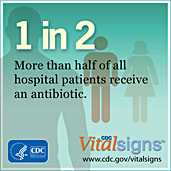| Reference |
Setting |
Key staff |
Intervention |
Impact |
| Saizy-Callaert S, Causse R, Furhman C, Le Paih MF, Thebault A and Chouaid C. Impact of a multidisciplinary approach to the control of antibiotic prescription in a general hospital. Journal of Hospital Infection. 2003 (53):177-182. |
600-bed teaching hospital, Creteil Cedex, France |
infectious disease physician, clinical pharmacist, bacteriologist |
Multidisciplinary-creation of a local prescribing guide, restricted prescription policy on most expensive antibiotics, regular assessment of antibiotics prescriptions and institutional training and information for prescribers. The program also implemented a named-patient prescription form for select costly and broad-spectrum antibiotics. |
Audits of use over three years showed that unjustified prescriptions initally fell (6% to 0% p<0.001), then increased (0% to 3% p<0.05), and then stabilized at 3%. Cost of antibiotics per inpatient day fell from $13.8 to $11 (p<0.001) over 3 years. Enterobacteriaceae producing extended-spectrum B-lactamase prevalance decreased from 12.5% to 3.6% over three years (p<0.001). MRSA and ceftazidime-resistent pseudomonas prevelance did not have significant changes (22.6% vs 19.5%/three years) and (28% vs. 30.9%/three years) respectively. |
| Singh N, Rogers P, Atwood CW, Wagener MW, Yu VL. Short-course Empiric Antibiotic Therapy for patients with pulomary infiltrates in the intensive care unit. American Journal of Respiratory and Critical Care Medicine. 2000, 162:505-511 |
146-bed, tertiary-care VA, Pittsburgh, PA, USA |
MICU physicians |
Guidelines – Patients with clinical pulmonary infection score (CPIS) less than or equal to 6 randomized to receive ciprofloxacin vs. standard care. Patientsin cipro group revaluated in 3 days. If CPIS >6, treated for pna, if CPIS <= 6, cipro discontinued. Follow-up cultures after 7 to 28 days. |
Antibiotic use continued beyond 3 days in 28% of cipro only vs. standard regimen patients. In patients with CPIS less than 6, antibiotics continued in 96% of standard therapy vs. 0% in cipro-only group. Total cost of antibiotics in experiemental group was $6,482 compared to $16,004 in standard therapy. Antimicrobal resistance or superinfection in 15% experimental vs. 35% in standard therapy. |
| Philmon C, Smith T, Williamson S, Goodman E. Controlling use of antimicrobials in a community teaching hospital. Infection Control and Hospital Epidemiology. 2006; 27(3):239-244 |
900-bed, community teaching hospital, Dallas, Texas, USA |
Infectious disease physican, 2 clinical pharmacist, microbiologist |
Three categories of inpatient antibiotic orders were monitored beginning in April 2001: conversion from intravenous to oral administration for selected highly bioavailable antimicrobials, cessation of perioperative prophylaxis within 24 hours for patients undergoing clean and clean-contaminated surgery, and consultation with an infectious diseases physician before continuing administration of selected drugs beyond 48 hours. |
From April 2001 through December 2003, a total of 1,426 requests for antimicrobial therapy met criteria for intervention. Overall physician compliance with the program was 76%, ranging from 57% for perioperative prophylaxis to 92% for intravenous to oral conversion. Antimicrobial costs per patient-day decreased by 31%, from $13.67 in 2000 (before program implementation) to $9.41 in 2003. Total savings in acquisition costs were $1,841,203 for the 3-year period. Ceftazidime resistance: Klebisella 73% reduction/3years, E. coli UTI 2% increase/3 years; cefepime reistance E. coli non-UTI 2% increase/3 years, Ceftriaxone resistance Klebsiella 75% decrease/3 years; cefuroxime resistance: Klebsiella 68% decrease/3 years; levofloxacin resistance: Klebsiella 78% decrease/3 years. |
| Geissler A, Gerbeuax P, Granier I, Blanc P, Facon K, Durand-Gasselin J. Rational use of antibiotics in the intensive care unit: impact on microbial resistance and costs. Intensive Care Medicine. 2003; 29(1):49-54 |
860-bed, general teaching hospital (intervention in 11-bed ICU), Toulon, France |
ICU physicians |
Guidelines – Creation of a rational-use algorithm to determine antibiotic use in an ICU setting. Algorithm included periodic review of appropriateness of antibiotic selection, oral route used systemically for adminstration of quinilones, and limiting the time period during which aminoglycosides can be used as dual therapy. |
Costs linked to antibiotics use showed a progressive reduction (100% for 1994, 81% for 1995, 65% for 1998). Antibiotic-selective pressure diminished (from 940 days of antibiotic use per 1,000 days (1994) to 610 (1998), p<10-5). A statistically significant reduction in nosocomial infections due to antimicrobial resistant micro-organisms was observed (from 37% (1994) to 15% (1998) of nosocomial infections, p<10-5) after 3 years of implementation of the policy. Methicillin resistance: S. aureus 79% reduction/4 years; Ceftazidime resistance: enterobacteriaceae 52% reduction/4 years, pseudamonas no significant change/4 year; ESBL: enterobacteriaceae no significant change/4 year. |
| Meyer E, Buttler J, Schneider C, Strehel E, Schroenen-Boersch B, Gastmeier P, Ruden H, Zentner J, Daschner FD, Schwab F. Modified guidelines impact on antibiotic use and costs: duration of treatment for pneumonia in a neurosurgical ICU is reduced. Journal of Antimicrobial Chemotherapy. 2007; 59(6):1148-1154 |
12-bed, neurosurgical ICU in a university-affiliated teaching hospital, Freiburg, Germany |
ICU physician, infection-control physician, microbiologist, pharmacist |
Guideline – Revision of guidelines for empirical treatment with antibiotics in ICUs including reducing the number of treatment days for nosocomial pneumonias and reducing carbapenem use in favor of zosyn for pseudomonas based based on susceptibility. |
Significant decrease in total antibiotic use from 949.8 to 626.7 DDD (defined daily doses)/1000 pd (patient days) after the intervention. This was mainly due to reduced consumption of second-generation cephalosporins (–100.6 DDD/1000 pd), imidazoles (–100.3 DDD/1000 pd), carbapenems (–33.3 DDD/1000 pd), penicillins with ß-lactamase inhibitor (–33.5 DDD/1000 pd) and glycopeptides (–30.2 DDD/1000 pd). Decrease in the proportion of methicillin-resistant Staphylococcus aureus (8.4% before and 2.9% after the intervention). Total antibiotic costs/pd showed a significant decrease from 13.16 euros/pd before to 7.31 euros /pd after the intervention. This is a saving of 5.85 euros/pd. |




 ShareCompartir
ShareCompartir